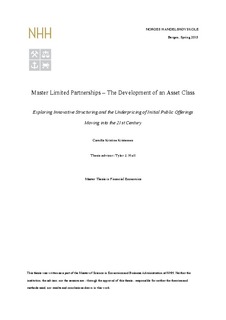| dc.description.abstract | This paper explores the development of the relatively young and emerging asset class of Master Limited Partnerships (“MLPs”) moving into the 21st century. The topic has been the subject of widespread coverage in the financial press over the last year, and represents an interesting research area both from a practitioner and academic point of view.
This paper approaches the subject from both angles, dividing the paper roughly into two parts. Part one consists of a qualitative assessment of how regulatory modifications and innovations in the MLP structure with regards to governance and tax treatment have allowed for a wider set of assets within the energy complex to exploit the MLP structure. Part two approaches the subject from an academic point of view, and examines the phenomenon of initial public offering (“IPO”) underpricing in the context of MLPs. For both parts, a sample of 100 MLP IPOs launched in the period from 1994 through November 2012 has been used.
Moving from the early MLPs in the 1980s to the asset class’ revival during the 2000s, I find that the MLP regulatory and business environment, investor mix, and asset diversity have changed. Contrasting to “traditional” MLPs, an increasing proportion of growth oriented firms with more volatile cash flows have entered the space, as have more leveraged firms. I thus find that MLPs are becoming less of an asset class per se, with deviations from the norm appearing quite frequently.
In the second part of my analysis I find that MLP IPOs are underpriced. The results are interesting because they contrast to previous research, and hence represent an addition to the current literature on IPO underpricing. For the full sample of 100 MLP IPOs, I find that the average initial return is 5.51 per cent. When dividing the sample into two groups containing pre-2004 and post-2004 IPOs respectively, I find that the average initial return for IPOs launched prior to 2004 is 1.73 per cent, and insignificantly different from zero. For the post-2004 IPOs, average initial return is 6.36 per cent, and significantly larger than zero. I associate the shift in underpricing with the passing of the American Jobs Creation Act of 2004, which introduced institutional ownership as a more meaningful source of financing for MLPs. On theoretical grounds, the shift in underpricing is consistent with the winner’s curse hypothesis. | no_NO |
